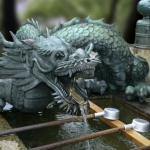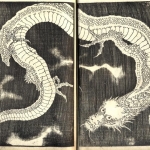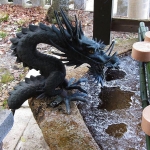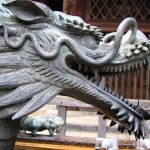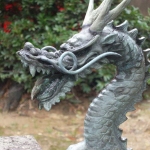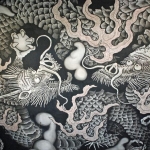Dragon
Symbol of Imperial Power, Guardian of the Eastern Direction, Deity of Rain and of Heaven, Protector of the Buddha and Buddhist Law.
Often depicted with a pearl or ball under its chin, which symbolizes thunder.
Turtles are the messengers of the Dragon
DRAGON MYTHOLOGY. A mythological animal of Chinese origin, and a member of the NAGA (Sanskrit) family of serpentine creatures who protect Buddhism. Japan’s dragon lore comes predominantly from China. Images of the reptilian dragon are found throughout Asia, and the pictorial form most widely recognized today was already prevalent in Chinese ink paintings in the Tang period (9th century AD). The mortal enemy of the dragon is the Phoenix, as well as the bird-man creature known as Karura. In contrast to Western mythology, Asian dragons are rarely depicted as malevolent. Although fearsome and powerful, they are equally considered just, benevolent, and the bringers of wealth and good fortune.
Dragons figure importantly in folk beliefs throughout Asia. Dragon lore was well established long before the birth of Buddhism in India (the latter around the 5th century BC). Buddhism was introduced to China by the 1st and 2nd centuries AD, and to Japan by the 6th century AD. By the 9th century AD, the Chinese had incorporated the dragon into Buddhist thought and iconography as a protector of the various Buddha and the Buddhist law. The dragon is also considered a shape shifter. These traditions were adopted by the Japanese. In both China and Japan, the character for “dragon” was often used in temple names. Even today, most Japanese Zen temples have a dragon painted on the ceiling of their assembly halls. Since they also preside over water, they are a talisman against fires. See Kennin-ji Temple.
DRAGON SYMBOLISM. The dragon corresponds to the season spring, the color green/blue, the element wood, and the virtue propriety; supports and maintains the country (controls rain, symbol of the Emperor’s power). Often paired with the Phoenix, for the two represent both conflict and wedded bliss. In both China and Japan, dragon and phoenix symbolism is associated closely with the imperial family — the emperor (dragon) and the empress (phoenix). The dragon also represents the yang principle; often portrayed surrounded by water or clouds. In both Chinese and Japanese mythology, the dragon is closely associated with the watery realm, and four dragon kings are said to rule over the four seas.


